美国政府结构
联邦和州的分权表
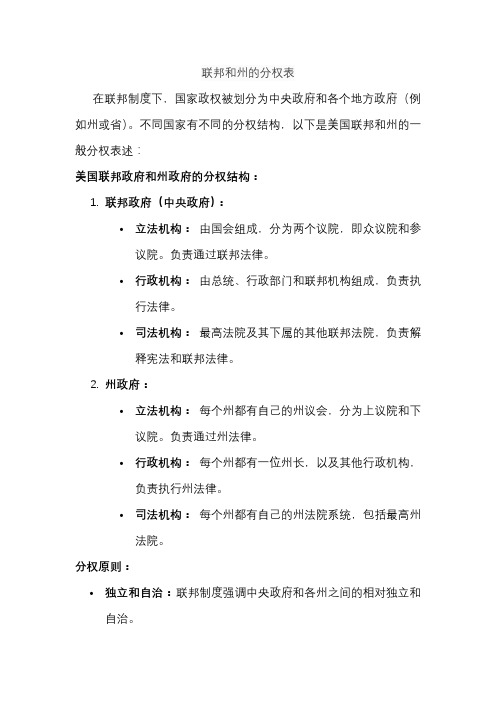
联邦和州的分权表
在联邦制度下,国家政权被划分为中央政府和各个地方政府(例如州或省)。
不同国家有不同的分权结构,以下是美国联邦和州的一般分权表述:
美国联邦政府和州政府的分权结构:
1.联邦政府(中央政府):
•立法机构:由国会组成,分为两个议院,即众议院和参议院。
负责通过联邦法律。
•行政机构:由总统、行政部门和联邦机构组成,负责执行法律。
•司法机构:最高法院及其下属的其他联邦法院,负责解释宪法和联邦法律。
2.州政府:
•立法机构:每个州都有自己的州议会,分为上议院和下议院。
负责通过州法律。
•行政机构:每个州都有一位州长,以及其他行政机构,负责执行州法律。
•司法机构:每个州都有自己的州法院系统,包括最高州法院。
分权原则:
•独立和自治:联邦制度强调中央政府和各州之间的相对独立和自治。
•共享权力:联邦和州政府在一些领域有共享的权力,例如税收、国防等。
•宪法限制:宪法规定了中央政府和各州的权力和责任,同时保护了个人的权利。
总体而言,美国的分权结构是基于宪法的原则,旨在保护个人自由、避免滥权,并促进中央和地方政府之间的合作。
其他国家的联邦和地方分权结构可能有所不同,取决于各自的宪法和法律体系。
美国政府结构以及对我国的启示
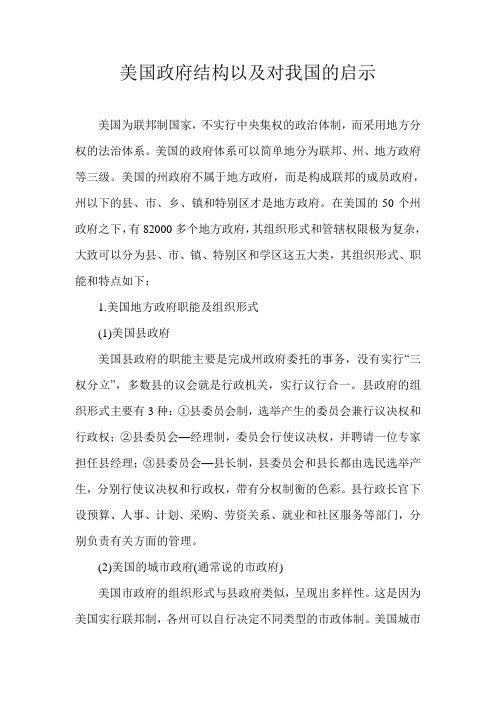
美国政府结构以及对我国的启示美国为联邦制国家,不实行中央集权的政治体制,而采用地方分权的法治体系。
美国的政府体系可以简单地分为联邦、州、地方政府等三级。
美国的州政府不属于地方政府,而是构成联邦的成员政府,州以下的县、市、乡、镇和特别区才是地方政府。
在美国的50个州政府之下,有82000多个地方政府,其组织形式和管辖权限极为复杂,大致可以分为县、市、镇、特别区和学区这五大类,其组织形式、职能和特点如下:1.美国地方政府职能及组织形式(1)美国县政府美国县政府的职能主要是完成州政府委托的事务,没有实行“三权分立”,多数县的议会就是行政机关,实行议行合一。
县政府的组织形式主要有3种:①县委员会制,选举产生的委员会兼行议决权和行政权;②县委员会—经理制,委员会行使议决权,并聘请一位专家担任县经理;③县委员会—县长制,县委员会和县长都由选民选举产生,分别行使议决权和行政权,带有分权制衡的色彩。
县行政长官下设预算、人事、计划、采购、劳资关系、就业和社区服务等部门,分别负责有关方面的管理。
(2)美国的城市政府(通常说的市政府)美国市政府的组织形式与县政府类似,呈现出多样性。
这是因为美国实行联邦制,各州可以自行决定不同类型的市政体制。
美国城市政府的组织形式主要有三种:①市长—议会制。
这种体制以分权为原则,市长行使执行权,市议会行使立法权。
这种体制内部有强市长型和弱市长型两种不同情况;②市议会—经理制。
小城市较多地实行这种市政体制。
市议会行使议决权,并公开招聘一位专家任市经理,授予市经理统一指挥市政府工作的全权,包括独立任免政府部门首长的权力;市议会议长兼市长,但只有礼仪性的职权;③市委员会制。
市委员组成市委员会,市委员会既是议会又是政府,每位委员既是议员又兼任若干个政府部门的首长,委员们推选其中一位主持会议,他就是市长,若轮流主持,市长就轮流担任。
市长没有否决权,只有一些礼仪性的职权。
[4](3)其他美国的乡镇由于人口不多,一般不设代议机构,乡镇民大会议决公共事务。
美国政府机构设置
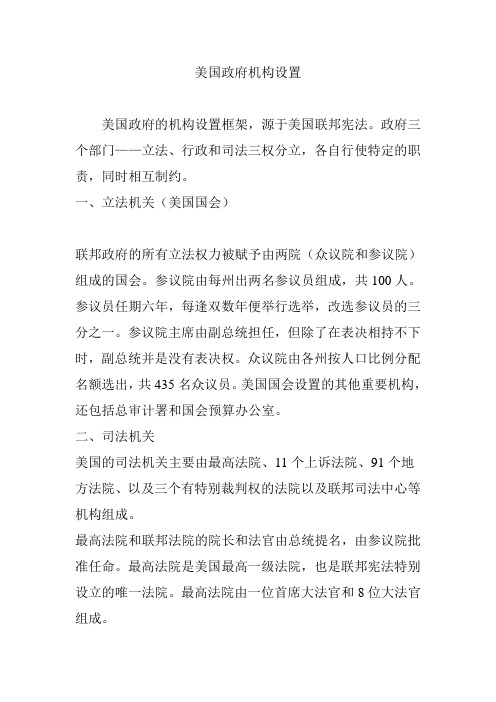
美国政府机构设置美国政府的机构设置框架,源于美国联邦宪法。
政府三个部门——立法、行政和司法三权分立,各自行使特定的职责,同时相互制约。
一、立法机关(美国国会)联邦政府的所有立法权力被赋予由两院(众议院和参议院)组成的国会。
参议院由每州出两名参议员组成,共100人。
参议员任期六年,每逢双数年便举行选举,改选参议员的三分之一。
参议院主席由副总统担任,但除了在表决相持不下时,副总统并是没有表决权。
众议院由各州按人口比例分配名额选出,共435名众议员。
美国国会设置的其他重要机构,还包括总审计署和国会预算办公室。
二、司法机关美国的司法机关主要由最高法院、11个上诉法院、91个地方法院、以及三个有特别裁判权的法院以及联邦司法中心等机构组成。
最高法院和联邦法院的院长和法官由总统提名,由参议院批准任命。
最高法院是美国最高一级法院,也是联邦宪法特别设立的唯一法院。
最高法院由一位首席大法官和8位大法官组成。
每个上诉法院有3-15名上诉法官。
地区法院是联邦法院系统的基层法院,每一地区法院有1-27 个法官。
三、行政部门机构设置美国总统领导的行政部门分为两部分:总统的办事机构和联邦政府的各部。
(一)总统和白宫1、总统2、总统内阁内阁成员由处理具体的国家及国际事务各部部长和总统指定的其他官员组成。
除副总统和国务卿外,还包括13个部的部长3、白宫“政研室”1)国家安全委员会主席由总统担任,其他法定成员包括副总统、国务卿和国防部长。
国家安全委员会帮助总统制定有关国家安全的国内外军事、情报和经济政策。
2)总统经济顾问委员会委员会由主席1人和委员2人组成。
委员会主席也称为总统首席经济顾问。
委员会的三名成员都由美国总统任命,并经参议院同意。
委员会有专业工作人员19名,任期1-2年。
其任务是:为总统分析全国经济情况,为制定国内外经济政策提供建议,协助总统准备提交国会的年度经济报告,为总统收集经济发展与动向的情报,评价联邦政府的各项经济政策与活动等。
美国地方政府的结构与职能
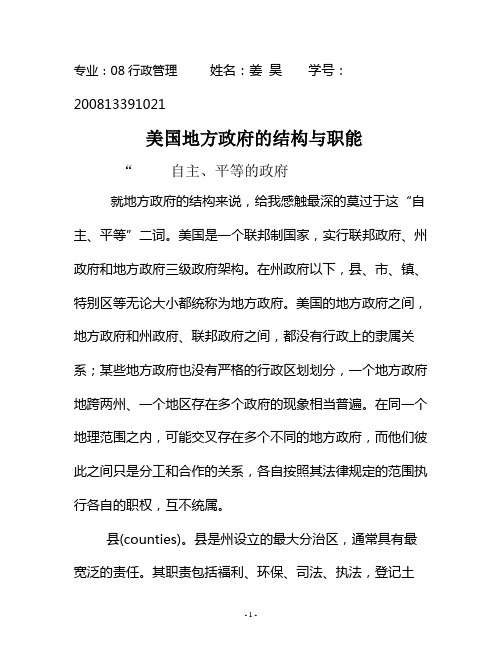
专业:08行政管理姓名:姜昊学号:200813391021美国地方政府的结构与职能“自主、平等的政府就地方政府的结构来说,给我感触最深的莫过于这“自主、平等”二词。
美国是一个联邦制国家,实行联邦政府、州政府和地方政府三级政府架构。
在州政府以下,县、市、镇、特别区等无论大小都统称为地方政府。
美国的地方政府之间,地方政府和州政府、联邦政府之间,都没有行政上的隶属关系;某些地方政府也没有严格的行政区划划分,一个地方政府地跨两州、一个地区存在多个政府的现象相当普遍。
在同一个地理范围之内,可能交叉存在多个不同的地方政府,而他们彼此之间只是分工和合作的关系,各自按照其法律规定的范围执行各自的职权,互不统属。
县(counties)。
县是州设立的最大分治区,通常具有最宽泛的责任。
其职责包括福利、环保、司法、执法,登记土地、出生和死亡,举办选举等。
美国除了康涅狄格和罗德岛州之外的所有各州都设置县或相当于县的单位。
在一些大城市,如纽约、旧金山、丹佛、费城等,县政府已与市政府合并,但在大多数地方,县市政府是交叉并存的。
县通常是地方政府中最具包容性的单位,美国人口中89%的人是由县级政府提供服务的。
自治市(municipalise)。
自治市作为一种地方政府单位是为了给更集中和更稠密的人口提供公共服务而设立的,是一种规模较大的市政自治体,是根据州政府颁发的特许状经营和管理、有明确划定区域的居民聚居单位。
在美国的官方统计中,自治市包括市、市镇和村镇等。
在美国,大的自治市人口可达数百万人,小的只有几百人。
自治市除了提供县和乡镇政府提供的服务外,一般来说还要创造和提供城市类型的服务。
在美国没有州一级的直辖市,国际大都市纽约和首都华盛顿都属于与县同一层次的特殊市。
乡镇(townships)。
美国除县和市以外,各州设有更小的行政单位,这些单位的名称各州很不相同,如乡、镇、村镇等。
即使同一个名称,其实际设立标准、法律地位、行政职能各州也不同。
美国的行政架构
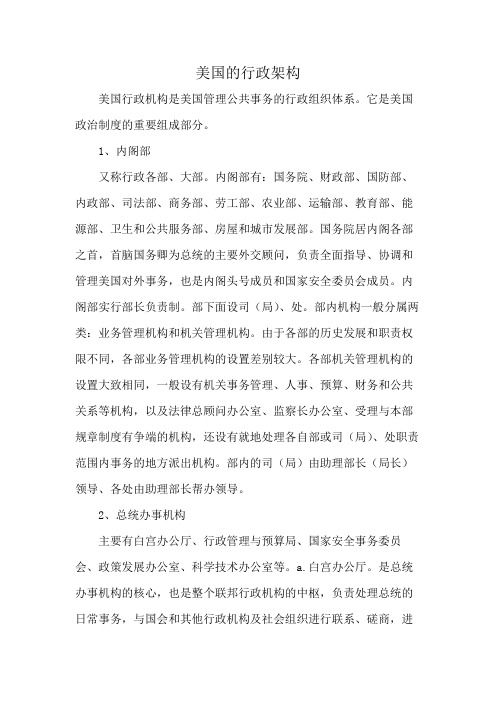
美国的行政架构美国行政机构是美国管理公共事务的行政组织体系。
它是美国政治制度的重要组成部分。
1、内阁部又称行政各部、大部。
内阁部有:国务院、财政部、国防部、内政部、司法部、商务部、劳工部、农业部、运输部、教育部、能源部、卫生和公共服务部、房屋和城市发展部。
国务院居内阁各部之首,首脑国务卿为总统的主要外交顾问,负责全面指导、协调和管理美国对外事务,也是内阁头号成员和国家安全委员会成员。
内阁部实行部长负责制。
部下面设司(局)、处。
部内机构一般分属两类:业务管理机构和机关管理机构。
由于各部的历史发展和职责权限不同,各部业务管理机构的设置差别较大。
各部机关管理机构的设置大致相同,一般设有机关事务管理、人事、预算、财务和公共关系等机构,以及法律总顾问办公室、监察长办公室、受理与本部规章制度有争端的机构,还设有就地处理各自部或司(局)、处职责范围内事务的地方派出机构。
部内的司(局)由助理部长(局长)领导、各处由助理部长帮办领导。
2、总统办事机构主要有白宫办公厅、行政管理与预算局、国家安全事务委员会、政策发展办公室、科学技术办公室等。
a.白宫办公厅。
是总统办事机构的核心,也是整个联邦行政机构的中枢,负责处理总统的日常事务,与国会和其他行政机构及社会组织进行联系、磋商,进而拟定有关政策。
b.行政管理与预算局。
是非党派机构,协助总统编制、执行联邦预算,推进行政改革。
c.国家安全事务委员会。
负责向总统提供与国家安全有关的内政、外交和军事方面的总体政策。
d.政策发展办公室。
负责协助总统拟定和协调国内政策的各种选择方案,并检查政府的主要国内政策。
e.科学技术办公室。
负责分析和鉴定政府有关科技、工程方面的主要政策、规划和计划项目,协助总统领导和协调各部门的科技发展。
其他总统办事机构也都是总统某方面行政决策的助手,发挥咨询、协调和监督功能。
3、独立机构是为完成政府专业管理和专门任务而设立的行政机构,占联邦行政机构的比例最大。
美国政治结构
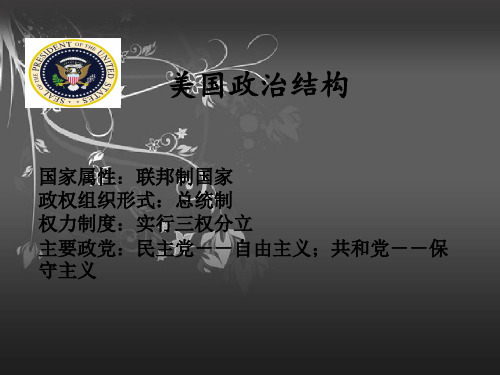
国家属性:联邦制国家 政权组织形式:总统制 权力制度:实行三权分立 主要政党:民主党--自由主义;共和党--保 守主义
联邦政府 美国的国家组织是依据三权分立与联邦制度、二大政治思想而制定, 当
初在起草宪法时因恐权力过分集中于个人或某一部门将危害人民的自由, 因而 将立法、司法, 行政三种权力分别独立, 互相制衡, 以避免政府滥权, 根据 宪法: 立法机关是参议院与众议院并设二院制议会, 司法机关以联邦最高法院 为首下设11个控诉法院, 95个地方法院及4个特别法庭。 行政机关是以由人民 直接选举的总统为最高行政首长, 并以副总统辅之, 下设行政部门。 政府的 权力有联邦政府、州政府之分, 宪法起草人根据政府必须接近百姓才不致剥夺 人民自由的原则, 将有关各州自治权保留给州政府, 各州政府本身拥有立法、 司法、行政诸权限, 联邦政府的权力系以一州政府无法单独行使者为限, 如课 税、财政、国防、 外交、货币银行、出入境管理、对外贸易、国民福利、邮政 , 以及科学艺术的发展援助等。
金会、武器管制及裁军总署、联邦邮政总局、美国国际交流总 署等。
经营范围 司法
美国的司法权力, 赋予一个最高法院, 以及国会可以随时制定及设立的次等法院
上诉 法院
最高 法院
地方 法院
特别 法庭
立法
经营范围
根据美国宪法第一条, 联邦政府将所有立法权力赋予参议院及众 议院组成的国会, 参议院由每州二名议员组成, 众议院议席按每 州人中多寡而定, 每五十万人选举一名众议员, 但保障每州至少 有一名, 目前有六州: 阿拉斯加、内华达、德拉华、北达科他、佛 蒙特及怀俄明等只有一名众议员, 相反的加利福尼亚州就有四十三 名众议员。 早期的国会议员并非由人民直接选举, 一直到一九一 三年通过的宪法第十七条修正案才规定参议院由人民直接投标选举, 宪法规定, 美国参议员必须至少年满三十岁, 成为美国公民至少 有九年, 众议员须至少廿五岁,成为美国公民至少七年, 二者均 需属所代表之各州的居民, 州议会把州划分为数个国会选区, 每 区的选民每二年选出一名众议员, 每逢双数年份便举行全国性的选 举选出参议员。 由于参议员的任期为六年, 故实际每二年仅改选 参议院的三分之一议席以避免国会的功能因改选而中辍。
美国行政体制
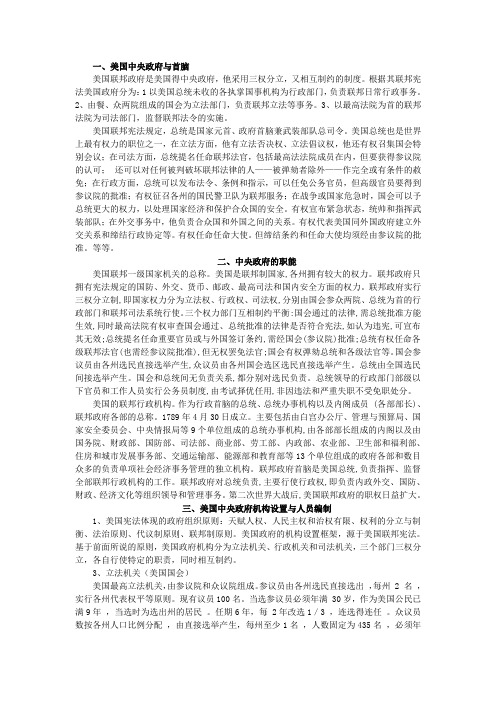
一、美国中央政府与首脑美国联邦政府是美国得中央政府,他采用三权分立,又相互制约的制度。
根据其联邦宪法美国政府分为:1以美国总统未收的各执掌国事机构为行政部门,负责联邦日常行政事务。
2、由餐、众两院组成的国会为立法部门,负责联邦立法等事务。
3、以最高法院为首的联邦法院为司法部门,监督联邦法令的实施。
美国联邦宪法规定,总统是国家元首、政府首脑兼武装部队总司令。
美国总统也是世界上最有权力的职位之一,在立法方面,他有立法否决权、立法倡议权,他还有权召集国会特别会议;在司法方面,总统提名任命联邦法官,包括最高法法院成员在内,但要获得参议院的认可;还可以对任何被判破坏联邦法律的人——被弹劾者除外——作完全或有条件的赦免;在行政方面,总统可以发布法令、条例和指示,可以任免公务官员,但高级官员要得到参议院的批准;有权征召各州的国民警卫队为联邦服务;在战争或国家危急时,国会可以予总统更大的权力,以处理国家经济和保护合众国的安全。
有权宣布紧急状态,统帅和指挥武装部队;在外交事务中,他负责合众国和外国之间的关系。
有权代表美国同外国政府建立外交关系和缔结行政协定等。
有权任命任命大使。
但缔结条约和任命大使均须经由参议院的批准。
等等。
二、中央政府的职能美国联邦一级国家机关的总称。
美国是联邦制国家,各州拥有较大的权力。
联邦政府只拥有宪法规定的国防、外交、货币、邮政、最高司法和国内安全方面的权力。
联邦政府实行三权分立制,即国家权力分为立法权、行政权、司法权,分别由国会参众两院、总统为首的行政部门和联邦司法系统行使。
三个权力部门互相制约平衡:国会通过的法律,需总统批准方能生效,同时最高法院有权审查国会通过、总统批准的法律是否符合宪法,如认为违宪,可宣布其无效;总统提名任命重要官员或与外国签订条约,需经国会(参议院)批准;总统有权任命各级联邦法官(也需经参议院批准),但无权罢免法官;国会有权弹劾总统和各级法官等。
国会参议员由各州选民直接选举产生,众议员由各州国会选区选民直接选举产生。
(精品)美国政体的结构与运作

美国政体的结构与运作封面:PictureQuest RF-Garry Black /Masterfile; Catherine Gehm(2005年10月发刊)目录美国联邦、州和地方政府概述─美国政府如何运作─美国宪法的作用─美国联邦、州、地方政府的相互关系美国政体与其他民主政体的异同联邦政府─立法分支立法程序参议院众议院─行政分支行政部门和机构─司法分支附录三权分立州政府─州政府结构州政府的权力与职责地方政府─地方政府结构选举与选举程序非政府组织及对公共政策有影响力的机构媒体特殊利益团体/非政府机构公共政策研究机构商贸组织工会个体和私营企业州和地方政府协会政党外国政府和多边组织附录美国政府资金来源词汇及网站资料鸣谢本刊承蒙BP America Inc.公司协助完成制作,发行人特此致谢。
对下列各位人士提供的信息协助也在此一并鸣谢:Douglas K. Barry, Ed.D., 美国商业部商务处(U.S. Commercial Service, U.S. Department of Commerce) Carol A. Bonosaro, 高级行政人员协会(Senior Executives Association)< Sheman, A.>总统教室计划(Presidential Classroom)Donald A. Ritchie, 美国参议院史料办公室(U.S. Senate Historical Office)Paul Rundquist, 原国会图书馆国会研究处(formerly Congressional Research Service, Library of Congress) Vincent T. Tizzio, 美国国际集团(American International Group)Dr. Andrew R. Uscher, 高级行政人员协会(Senior Executives Association)David K. Voight, 美国小企业管理局(U.S. Small Business Administration)美国联邦、州和地方政府概述美国政府体制始于1776年,最初只是一个基于自由和民主理念的试验。
美国地方管理制度
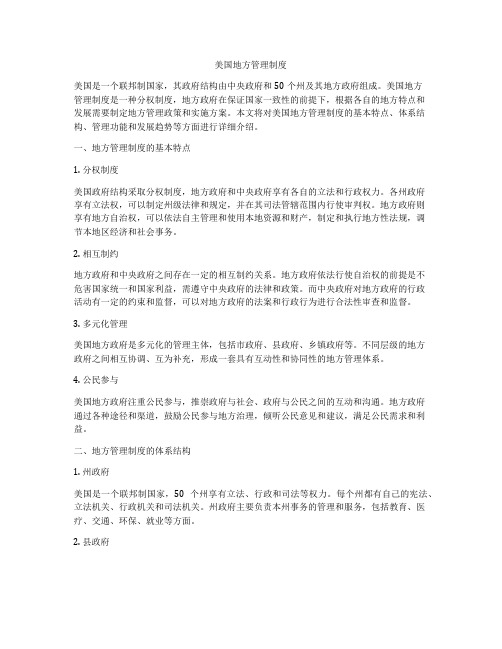
美国地方管理制度美国是一个联邦制国家,其政府结构由中央政府和50个州及其地方政府组成。
美国地方管理制度是一种分权制度,地方政府在保证国家一致性的前提下,根据各自的地方特点和发展需要制定地方管理政策和实施方案。
本文将对美国地方管理制度的基本特点、体系结构、管理功能和发展趋势等方面进行详细介绍。
一、地方管理制度的基本特点1. 分权制度美国政府结构采取分权制度,地方政府和中央政府享有各自的立法和行政权力。
各州政府享有立法权,可以制定州级法律和规定,并在其司法管辖范围内行使审判权。
地方政府则享有地方自治权,可以依法自主管理和使用本地资源和财产,制定和执行地方性法规,调节本地区经济和社会事务。
2. 相互制约地方政府和中央政府之间存在一定的相互制约关系。
地方政府依法行使自治权的前提是不危害国家统一和国家利益,需遵守中央政府的法律和政策。
而中央政府对地方政府的行政活动有一定的约束和监督,可以对地方政府的法案和行政行为进行合法性审查和监督。
3. 多元化管理美国地方政府是多元化的管理主体,包括市政府、县政府、乡镇政府等。
不同层级的地方政府之间相互协调、互为补充,形成一套具有互动性和协同性的地方管理体系。
4. 公民参与美国地方政府注重公民参与,推崇政府与社会、政府与公民之间的互动和沟通。
地方政府通过各种途径和渠道,鼓励公民参与地方治理,倾听公民意见和建议,满足公民需求和利益。
二、地方管理制度的体系结构1. 州政府美国是一个联邦制国家,50个州享有立法、行政和司法等权力。
每个州都有自己的宪法、立法机关、行政机关和司法机关。
州政府主要负责本州事务的管理和服务,包括教育、医疗、交通、环保、就业等方面。
2. 县政府每个州都分成若干个县,每个县都设有县政府。
县政府是地方政府的最基层单位,主要负责本县公共服务和管理。
县政府的职能包括土地管理、基础设施建设、社会福利、文化教育、环境保护等方面。
3. 市政府每个县内都包括若干个不同规模的城市,每个城市都设有市政府。
美国政府机构设置

美国政府机构设置美国政府的机构设置框架,源于美国联邦宪法。
政府三个部门——立法、行政和司法三权分立,各自行使特定的职责,同时相互制约。
一、立法机关(美国国会)联邦政府的所有立法权力被赋予由两院(众议院和参议院)组成的国会。
参议院由每州出两名参议员组成,共100人。
参议员任期六年,每逢双数年便举行选举,改选参议员的三分之一。
参议院主席由副总统担任,但除了在表决相持不下时,副总统并是没有表决权。
众议院由各州按人口比例分配名额选出,共435名众议员。
美国国会设置的其他重要机构,还包括总审计署和国会预算办公室。
二、司法机关美国的司法机关主要由最高法院、11个上诉法院、91个地方法院、以及三个有特别裁判权的法院以及联邦司法中心等机构组成。
最高法院和联邦法院的院长和法官由总统提名,由参议院批准任命。
最高法院是美国最高一级法院,也是联邦宪法特别设立的唯一法院。
最高法院由一位首席大法官和8位大法官组成。
每个上诉法院有3-15名上诉法官。
地区法院是联邦法院系统的基层法院,每一地区法院有1-27 个法官。
三、行政部门机构设置美国总统领导的行政部门分为两部分:总统的办事机构和联邦政府的各部。
(一)总统和白宫1、总统2、总统内阁内阁成员由处理具体的国家及国际事务各部部长和总统指定的其他官员组成。
除副总统和国务卿外,还包括13个部的部长3、白宫“政研室”1)国家安全委员会主席由总统担任,其他法定成员包括副总统、国务卿和国防部长。
国家安全委员会帮助总统制定有关国家安全的国内外军事、情报和经济政策。
2)总统经济顾问委员会委员会由主席1人和委员2人组成。
委员会主席也称为总统首席经济顾问。
委员会的三名成员都由美国总统任命,并经参议院同意。
委员会有专业工作人员19名,任期1-2年。
其任务是:为总统分析全国经济情况,为制定国内外经济政策提供建议,协助总统准备提交国会的年度经济报告,为总统收集经济发展与动向的情报,评价联邦政府的各项经济政策与活动等。
美国行政体制
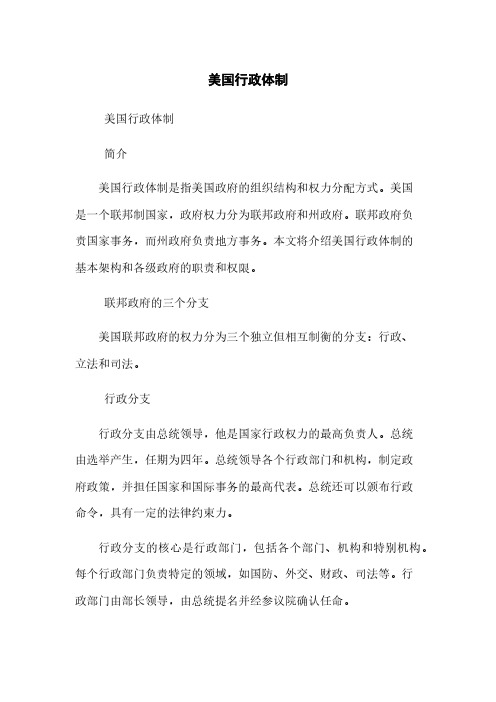
美国行政体制美国行政体制简介美国行政体制是指美国政府的组织结构和权力分配方式。
美国是一个联邦制国家,政府权力分为联邦政府和州政府。
联邦政府负责国家事务,而州政府负责地方事务。
本文将介绍美国行政体制的基本架构和各级政府的职责和权限。
联邦政府的三个分支美国联邦政府的权力分为三个独立但相互制衡的分支:行政、立法和司法。
行政分支行政分支由总统领导,他是国家行政权力的最高负责人。
总统由选举产生,任期为四年。
总统领导各个行政部门和机构,制定政府政策,并担任国家和国际事务的最高代表。
总统还可以颁布行政命令,具有一定的法律约束力。
行政分支的核心是行政部门,包括各个部门、机构和特别机构。
每个行政部门负责特定的领域,如国防、外交、财政、司法等。
行政部门由部长领导,由总统提名并经参议院确认任命。
立法分支立法分支由国会领导,由参议院和众议院组成。
国会是美国的立法机构,负责制定和通过法律。
参议院有100个议员,每个州分配两名议员,任期为六年。
众议院有435名议员,按照各州人口分配,任期为两年。
国会制定法律的过程通常需要总统签署成为法律。
如果总统否决,国会可以通过三分之二多数票覆盖总统的否决。
司法分支司法分支由最高法院及其下属的其他联邦法院组成。
最高法院是最高级的联邦法院,由九名大法官组成。
最高法院负责解释和审查法律的合宪性,并裁决有关法律争议的案件。
其判决具有最高的法律效力,对下级法院和各级政府具有约束力。
州政府和地方政府除了联邦政府的三个分支外,美国还有州政府和地方政府,负责地方事务的管理。
州政府美国由50个州组成,每个州都有自己的州政府,行使一定的自治权。
州政府的组织结构和职责类似于联邦政府的三个分支,包括州长、州议会和州法院。
州长是州政府的最高行政长官,负责领导州政府的行政部门,制定并实施州政策。
州议会由州参议院和州众议院组成,负责制定州法律。
州法院负责解释州法律,并处理州级的法律纠纷。
地方政府地方政府是指州政府下属的县政府、城市政府等,负责管理各个地方地区的事务。
美国官员制度

美国官员制度:解读美国政府权力分配与运作导语:美国官员制度是美国政府权力运作的核心。
作为一个民主共和制度的国家,美国的政府权力分散并存在着一系列的制衡机制。
本文将对美国官员制度进行详细解读,包括其结构、职责和运作方式,帮助读者更好地理解美国政府的运作机制。
一、美国官员制度的结构:1. 行政部门(Executive Branch):美国行政部门由总统、内阁及其所属的各个联邦部门组成。
总统是行政部门的最高权力机构。
根据美国宪法,总统是全国选民通过选举产生的。
行政部门的职责包括制定政策、执行法律以及管理国家事务。
2. 立法部门(Legislative Branch):美国立法部门由国会组成,分为两个独立但又互相制衡的议会机构:众议院和参议院。
众议院的议席根据各州人口数量进行分配,参议院每个州均有两个代表。
立法部门的职责是制定和通过法律,监督行政部门的运作。
3. 司法部门(Judicial Branch):美国司法部门由最高法院和其他联邦法院组成。
最高法院由法官组成,其职责是审理和解决各级联邦法院的上诉案件以及宪法争议。
司法部门负责解释和维护宪法的权威,确保司法公正和法律适用。
二、美国官员的职责:1. 总统(President):美国总统是行政部门的首脑和最高指挥官。
总统具有广泛的职权,包括签署和否决法案、任命高级政府官员、制定国家外交政策、指挥军队等。
总统还代表美国国家利益与国内外政府和组织进行谈判和协商。
2. 内阁(Cabinet):内阁由总统任命的各部长组成,包括国务卿、财政部长、国防部长等。
内阁成员负责管理各自的部门并为总统提供建议和支持。
内阁的职责涵盖了国内和国际事务的管理和协调。
3. 国会(Congress):众议院和参议院是美国国会的两个分支。
国会的主要职责是立法。
众议院的议员代表各州的选民,参议院的议员代表各州。
国会成员还有权审查总统和内阁的决策,监督行政部门的运作,并参与国家政策的制定。
美国联邦政府与各州政府间的权力结构和分配

美国联邦政府与各州政府间的权力结构和分配美国联邦政府与各州政府是美国政治体系中的两个主要政治实体。
它们之间的权力结构和分配是美国政治体系的核心之一。
根据美国宪法的规定,联邦政府和各州政府有各自的权力范围,但它们之间的权力分配又有很多灰色地带。
本文将探讨美国联邦政府与各州政府间的权力结构和分配。
权力结构首先,我们需要了解美国政治体系中联邦政府和各州政府的权力结构。
美国政治体系是一种联邦制政府,即政治权力由中央政府和地方政府共同拥有。
这种联邦制政府的特点是,中央政府和地方政府各自有自己的权力范围,但是,它们之间的权力分配需要通过宪法进行规定和约束。
联邦政府的权力主要来源于美国宪法。
根据美国宪法的规定,联邦政府的主要权力包括外交、国防、货币政策、联邦税收等。
联邦政府的权力可以通过立法、行政、司法等方式进行行使。
与联邦政府不同的是,各州政府的权力是由各自的州宪法规定的。
各州政府的权力主要包括关于地方事务的管理、教育、公共卫生等。
各州政府和地方政府的权力分配也有区别。
在一些州中,州政府比地方政府更强大;而在另一些州中,地方政府则更加强大。
权力分配了解了联邦政府和各州政府的权力结构之后,我们需要进一步探讨这些权力的分配。
一般来说,联邦政府和各州政府的权力范围是不同的,但是有一些权力是重叠的。
例如,治安、交通、环境保护等问题涉及到联邦政府和各州政府的双重权力。
在这些问题上,联邦政府和各州政府会协商,通过合作来解决问题。
此外,美国宪法还规定了一些限制,以控制联邦政府和各州政府的权力。
其中最重要的限制是宪法修正案。
宪法修正案是指通过美国宪法的修改来修改或加强保护某些权利。
例如,第十条修正案规定,各州有权行使联邦政府未行使的权力。
这意味着联邦政府不能侵犯各州的权力。
另一个重要的限制是最高法院的判决。
最高法院是美国司法体系的最高权力,它对联邦政府和各州政府的政策进行监督。
最高法院的判决具有法律效力,必须得到联邦政府和各州政府的遵守。
美国知识点总结政治

美国知识点总结政治美国政治体系概述美国政治体系是一个联邦制度体系,由联邦政府和50个州政府共同组成。
联邦政府分为三个独立的分支,分别是行政机构、立法机构和司法机构。
行政机构由总统和内阁组成,负责实施法律和政策。
立法机构由国会组成,包括参议院和众议院,负责制定和通过法律。
司法机构由最高法院和其他联邦法院组成,负责解释法律和处理司法案件。
美国政治体系的分权制衡设计使得各个政府机构之间相互制衡,保障了政府权力的相互监督和平衡。
美国政府机构总统制: 美国总统是国家元首和政府首脑,负责领导国家的行政事务,并拥有一定的法律和行政权力。
总统由选举产生,任期为4年,最多连任两届。
总统具有宣布国家紧急状态、签署行政命令、任命内阁成员和最高法院大法官等权力。
国会: 美国国会是立法机构,由参议院和众议院两个议院组成。
参议院每州两名议员,共100名,任期为6年;众议院根据各州人口分配议席,共435名,任期为2年。
国会负责制定和通过法律,同时对总统和政府机构进行监督和调查。
最高法院: 美国最高法院是联邦最高司法机构,负责解释宪法和处理联邦法律案件。
最高法院由九名大法官组成,任期终身。
最高法院具有裁定法律合宪性、解决州际纠纷和处理与联邦法律和宪法相关的案件等权力。
州政府: 美国有50个州,每个州都有自己的政府体系和宪法,由州长和州议会组成。
州政府负责管理州内事务,包括教育、卫生、交通、税收等。
州政府在许多事务上拥有独立的权力,例如制定州级法律、管理地方财政和监管州内公共事务等。
政党制度美国的政治制度是多党制度,两大主要政党是民主党和共和党。
这两个政党在国家政治中占据主导地位,并在国会和总统选举中竞争激烈。
除此之外,还有一些小型的政党和无党派人士在美国政治中活跃。
政党在选举中组织候选人、制定政策纲领、吸引选民支持,并在国会和政府中发挥影响力。
选举制度美国的总统由选举产生,采用选举人制度。
选举人根据各州的人口数量分配,共有538名选举人,每个州根据其参议院和众议院议席加上2名选举人进行分配。
美国行政制度
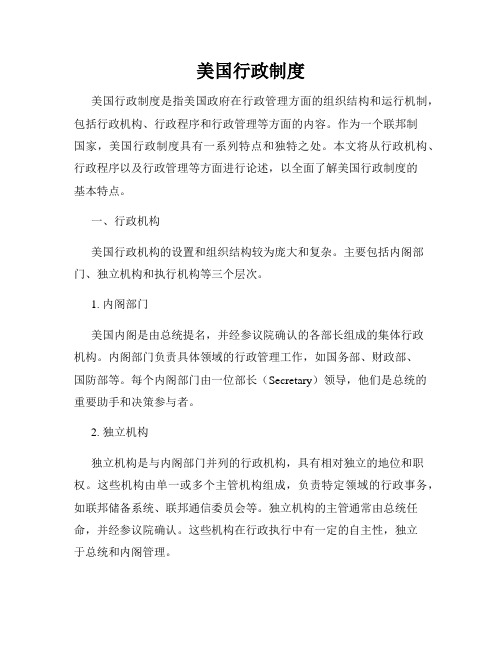
美国行政制度美国行政制度是指美国政府在行政管理方面的组织结构和运行机制,包括行政机构、行政程序和行政管理等方面的内容。
作为一个联邦制国家,美国行政制度具有一系列特点和独特之处。
本文将从行政机构、行政程序以及行政管理等方面进行论述,以全面了解美国行政制度的基本特点。
一、行政机构美国行政机构的设置和组织结构较为庞大和复杂。
主要包括内阁部门、独立机构和执行机构等三个层次。
1. 内阁部门美国内阁是由总统提名,并经参议院确认的各部长组成的集体行政机构。
内阁部门负责具体领域的行政管理工作,如国务部、财政部、国防部等。
每个内阁部门由一位部长(Secretary)领导,他们是总统的重要助手和决策参与者。
2. 独立机构独立机构是与内阁部门并列的行政机构,具有相对独立的地位和职权。
这些机构由单一或多个主管机构组成,负责特定领域的行政事务,如联邦储备系统、联邦通信委员会等。
独立机构的主管通常由总统任命,并经参议院确认。
这些机构在行政执行中有一定的自主性,独立于总统和内阁管理。
3. 执行机构执行机构是负责执行具体行政任务的机构,包括各级行政管理机构、监管机构、执法机构等。
这些机构具体负责各种行政管理工作,如国土安全部、环保局、联邦航空管理局等。
执行机构由总统或地方政府任命的高级官员负责,并拥有一定的处罚和调查权力。
二、行政程序美国行政程序包括立法、决策和行政诉讼等环节,确保行政权力的合法行使和监督。
1. 立法美国行政程序中的立法环节主要包括制定行政法规和规章制度等。
根据美国宪法,行政部门有权制定法规,以填补法律的具体细节和实施要求。
创立或修改法规的程序要遵循制定程序法和公众参与原则。
2. 决策美国行政决策主要是指内阁及独立机构等行政机构在特定的案件或问题上做出具体决策。
这些决策由行政机构中的高级官员负责,需要遵守法律和程序的要求,并保证决策的公正性和合理性。
3. 行政诉讼在美国行政程序中,行政诉讼是公民和企业对政府行政行为进行法律追诉的方法。
美国和中国的政治体系有何不同之处?
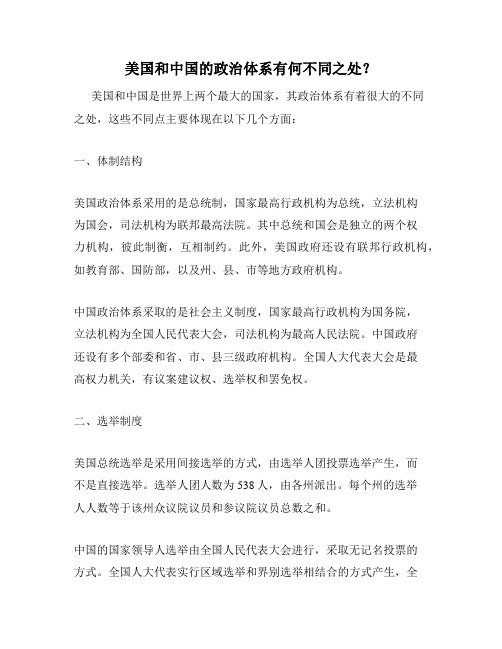
美国和中国的政治体系有何不同之处?美国和中国是世界上两个最大的国家,其政治体系有着很大的不同之处,这些不同点主要体现在以下几个方面:一、体制结构美国政治体系采用的是总统制,国家最高行政机构为总统,立法机构为国会,司法机构为联邦最高法院。
其中总统和国会是独立的两个权力机构,彼此制衡,互相制约。
此外,美国政府还设有联邦行政机构,如教育部、国防部,以及州、县、市等地方政府机构。
中国政治体系采取的是社会主义制度,国家最高行政机构为国务院,立法机构为全国人民代表大会,司法机构为最高人民法院。
中国政府还设有多个部委和省、市、县三级政府机构。
全国人大代表大会是最高权力机关,有议案建议权、选举权和罢免权。
二、选举制度美国总统选举是采用间接选举的方式,由选举人团投票选举产生,而不是直接选举。
选举人团人数为538人,由各州派出。
每个州的选举人人数等于该州众议院议员和参议院议员总数之和。
中国的国家领导人选举由全国人民代表大会进行,采取无记名投票的方式。
全国人大代表实行区域选举和界别选举相结合的方式产生,全国人大代表的名额按照各个省、自治区、直辖市和中央部委的人口、面积和国民经济总量等因素进行分配。
三、政府职责美国政府的职责是维护国家安全、维护社会稳定、保护公民权利、促进经济发展、提高人民生活水平。
在外交方面,美国政府在维护其国家利益的同时,也在推动全球治理、维护世界和平和稳定方面扮演着重要角色。
中国政府的职责是维护国家安全、促进经济发展、保障人民民主权利、改善民生福利、推动社会和谐稳定、参与构建新型全球治理。
中国政府在外交方面秉持和平共处五项原则,积极参与全球治理体系的建设。
四、政治运作方式美国政治运作方式十分民主化,政策制定过程和政治运动可以以多种方式进行,如投票、请愿、示威等。
美国社会有着非常完善的检查和平衡机制,保证了政权轮替的和平交接,确保了政治的稳定和可持续性。
中国政治运作方式比较稳定,依据党的路线方针政策,坚持领导权在党和人民当中,以“三会一课”、“两学一做”为核心,通过加强思想教育、加强组织建设,推动党的领导力、纪律和创新保持着高度的活力。
分析美国的国家结构形式及其特点。

分析美国的国家结构形式及其特点。
美国的国家结构形式是一个联邦制,具有以下特点:1.联邦主权:美国的政治权力被分配给中央政府(联邦政府)和各州政府(州政府)两个层面。
联邦政府负责国家层面的事务,如国防、外交和货币政策等,而州政府负责各州的内部事务,如教育、交通和公共安全等。
两个层面的政府各具有相对独立的政治和行政权力。
2.权力分立:美国的政治体系采取权力分立的原则,将立法、行政和司法权力分别授予国会、行政部门和司法机构。
这种分立机构和权力的构架旨在实现权力的制衡和防止滥用。
3.双重主权:美国的国家结构体现了双重主权的特点,即联邦政府和各州政府分别享有一定的主权。
联邦政府在宪法规定的领域内行使权力,而各州政府在未被联邦政府明确规定的领域内保留一定的自主权。
4.权力分配和混合制衡:根据宪法,联邦政府拥有特定的权限,如制定外交政策、货币发行和国防等。
各州政府则保留了其他未被明确授予联邦政府的权力范围。
这种混合制衡使得不同层面的政府在政治和法律上相互制衡,确保权力分配的平衡性。
5.法治和宪政保障:美国的国家结构体现了法治和宪政的原则,所有政府行为都受到宪法和法律的约束。
宪法是最高法律文件,确保政府行使权力的合法性和公正性。
此外,美国的司法机构具有对政府行为进行合宪性审查的权力,以保障法治原则的实施。
美国的国家结构体现了分权、制衡和法治的价值观。
通过联邦制和权力分立原则,美国实现了中央与地方政府之间的分权和协调,并最大限度地保护公民的自由和权益。
这种制度设计为国家提供了灵活性和民主性,同时也带来了各种政治、经济和社会挑战。
美国政府制度的知识点总结

美国政府制度的知识点总结美国政府制度是一个成熟的、多元的政治体系,其政府制度的特点吸引着世界各国的关注。
在美国政府制度中,权力分为三个部分:行政、立法和司法,由此保证了政府的制衡性。
本文将详细介绍美国政府制度的组织结构、运作原则、权力机构和选举制度等内容。
一、美国政府制度的组织结构1. 联邦政府结构美国政府是一个联邦共和制度,根据宪法规定,权力被分配给联邦政府和各州政府。
联邦政府由三个分立的分支组成:行政部门、立法部门和司法部门。
行政部门由总统、副总统和内阁组成,负责执行法律;立法部门由国会组成,负责起草和通过法律;司法部门由最高法院和其他联邦法院组成,负责解释和执行法律。
2. 州政府结构美国各州政府也以类似的三权分立的方式组织。
每个州都有行政、立法和司法三个分支。
州议会负责通过法律,州长负责执行法律,州最高法院负责解释法律。
3. 地方政府结构地方政府包括县、市和镇等,它们负责管理本地事务,如建设、教育、警察、消防等。
二、美国政府制度的运作原则1. 统一性美国政府的统一性指的是联邦政府和各州政府之间相互依存,共同面对国内外挑战。
联邦政府拥有特定的权力,州政府也拥有独立的权力,但二者之间必须合作,共同解决问题。
2. 权力制衡美国政府的权力制衡体现在三权分立,行政、立法、司法之间相互制约,以防止权力过度集中导致的滥用。
3. 民主机制美国政府采用代议制民主制度,选民通过选举方式选出代表,代表负责制定和执行政策。
此外,政府还依赖民意调查、市民参与以及法治监督的机制,确保政治决策的公平和透明。
4. 法治原则美国政府依法治国,法律是治理国家的基本标准,所有行政行为都必须遵守法律的规定。
5. 公共利益美国政府制定政策和决策时考虑的首要原则是公共利益,即要维护国家和人民的长远利益。
三、美国政府制度的权力机构1. 行政权机构美国行政权由总统及其内阁组成。
总统是联邦政府的首脑,负责执行国家政策和法律,指挥军队,外交和国防事务。
美国行政制度

(三)中央情报局
1947年建立。法律上规定其职责是向国家安全 委员会提供情报,对各情报机构进行监督、协调, 对情报加以整理和评价以及为国家安全委员会获取 情报而执行其他职能和任务。实际上中央情报局的 主要任务是搜集情报、监督情报的传送,为此从事 国内外间谍活动、颠覆活动。中央情报局是个神秘 单位,历届美国总统很重视,但近年来屡屡失误, 引起国内各界的不满。
(二)内阁与议会的关系不同。
英国内阁成员必须是议会议员,内阁对议会 负责,议会有权投不信任票。而美国内阁成员则 不能是议员,也不对议会负责,国会也没有倒阁 权。美国内阁成员都注意总统的态度,对总统负 责,因为总统雇用了他,也可以解雇他。
美国内阁与英国内阁不同之处
(三)总统和内阁成员之间的关系不同。 英国首相与内阁成员之间是伙伴关系,他们都 是执政党的重要人物,一荣俱荣,一枯俱枯。而 美国总统与内阁成员之间是个人关系,甚至是一 种雇用关系,总统的着眼点是找到合适的人选, 完成其交给的任务,因此,他甚至可以任命不同 党派的人担任政府的要职,只要能完成任务。内 阁成员不可能否决总统的某项政策。
国防部
1949年将“国家军事机构”改名为国防部, 成为联邦政府正式的部。国防部的主要职权是根 据总统的命令组建、训练军队,提出有关军事方 面的政策建议和立法议案,具有对武装部队的指 挥权和新式武器制造权,统筹军事预算和作总统 的主要军事顾问,并直接领导参谋长联席会议。 国防部对总统对外政策的制定和实施有较大影响。
美国内阁与英国内阁不同之处
尽管在实际政治生活中存在着内阁这一机构, 但它与实行内阁制政府的国家(如英国)的内阁 有着本质的差别。这些差别是:
(一)内阁的性质不同。 英国内阁是一个集体决策机构,实行集体负 责制,首相虽然权力很大,但如果在某个重要问 题上受到内阁集体否决,他就有可能因此下台。
- 1、下载文档前请自行甄别文档内容的完整性,平台不提供额外的编辑、内容补充、找答案等附加服务。
- 2、"仅部分预览"的文档,不可在线预览部分如存在完整性等问题,可反馈申请退款(可完整预览的文档不适用该条件!)。
- 3、如文档侵犯您的权益,请联系客服反馈,我们会尽快为您处理(人工客服工作时间:9:00-18:30)。
Structure of U.S Government—美国政府的结构
The United States is a republic which operates under federalist system. The national government has specific, enumerated powers, and the fifty sovereign states retain substantial autonomy and authority over their respective citizens and residents. Both the national government and each state government are divided into executive, legislative, and judicial branches. Written constitutions, both federal and state, form a system of separated powers, checksand balances among the branches.
美国是一个在联邦体系运转下的共和国。
联邦政府有列举的、具体的权利,而五十个自治州保留了对自己公民和居民的实质主权和职权。
联邦政府和州政府都被划分为行政、立法、司法机构。
无论联邦抑或州,成文宪法形成了这些机构间相互制衡的分权体系。
National-Subnational Relations
国家与州的关系
Any powers not delegated to the federal government in the U.S. Constitution, nor prohibited by it to the states, are reserved to the states or to the people. (U.S. Const. amend. X. )Nonetheless, the powers of the federal government are extensive.
The federal government's authority to regulate interstate commerce (U.S. Const. art. I, sec. 8, cl. 3)makes it the predominant force in environmental regulation. The states, under their general police powers to protect the public health, safety and welfare, also retain substantial independent authority to issue environmental protection laws applicable to their citizens and residents.
任何既没有在美国宪法中授权给联邦政府、也没有被宪法禁止授权给各州的权力,是保留给各州或人民的。
(美国宪法第五修正案)尽管如此,联邦政府的权力仍是广泛的。
规范州际贸易的职权使得联邦政府在环境规制方面有着突出的影响力。
各州在他们的普通警力之下保护公众的健康、安全和福利,同时也保留了发布适用于本州公民和居民的环境保护法律方向的独立的、实质上的职权。
Potential conflicts between state and federal regulation in all areas, including environmental protection, are governed by the Supremacy Clause of the United States Constitution. (U.S. Const. art. VI. )The federal Constitution, federal laws, and international treaties are supreme to state or local law; state and local laws that contradict federal laws or treaties are thus preempted and can be declared unconstitutional by a federal court.
联邦与州规则间在所有领域的潜在冲突,包括环保,都由美国宪法最高条款管辖。
联邦宪法、联邦法律及国际条约优于州或当地的法律;因此,与联邦法律和条约发生抵触的州或当地的法律是要避免的,它可以被联邦法庭宣布为违宪。
Although the Constitution sets forth the basic framework for national and subnational relationships in the U.S., many environmental statutes add detail to specific aspects of those relationships within the broader constitutional framework. For example, federal statutes might explicitly preempt, or explicitly waive any preemption of, state law. See, e.g., Toxic Substance Control Act (TSCA), 15 U.S.C. sec. 2617; Clean Water Act (CWA), 33 U.S.C. sec. 1370; Comprehensive Environmental Response, Compensation and Liability Act (CERCLA), 42 U.S.C. sec. 9614; and Resource Conservation and Recovery Act (RCRA), 42 U.S.C. sec. 6929. Some federal environmental statutes create national minimum standards delegating primary implementation of federal programs to states that meet certain federal standards. States are free to enact stricter regulations. See, e.g., CWA, 33 U.S.C. sec. 1370; RCRA, 42 U.S.C. sec. 6929. When a state is delegated federal authority, the U.S. Environmental Protection Agency (EPA) and the state will sign a Memorandum of Agreement establishing their respective responsibilities and necessary procedures. Many federal environmental statutes also provide for grants, technical assistance and other support to assist the states in furthering national policies or programs. See, e.g., TSCA, 15 U.S.C. sec. 2627; CWA, 33 U.S.C. sec. 1329 (h). A U.S. citizen can be subject to both federal and state law on environmental issues.
尽管美国宪法阐述了国家与州关系的基本框架,但是许多环境条例仍在广泛宪法框架下对这些关系的具体方面增加了细节。
例如,联邦法律对于州法律,可以有明确的优先权,也可以明确地放弃这种优先权。
(列举:某某案例)。
一些联邦环境条例规定了国家最低标准,同时授权那些满足了某一联邦标准的州实施联邦的计划。
各州可以自由制定更严格的规则(列举:某某案例)。
当联邦授权给州时,美国环境保护机构(EPA)和州会签署一份协议备忘录来确立各自的责任和必要的程序。
许多联邦环境条例也规定了提供资金、技术援助及其他支持以帮助州更进一步执行国家政策和计划。
美国公民在环境问题上既要服从联邦法律又要服从州法律。
